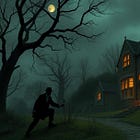The Confabulannotated Sherlock Holmes, Chapter 3.3
Featuring listicle pamphlets, neckwear advertising campaigns and the overconfidence of nineteenth century scientists
NOTE: If you have received this via email, you may find it easier to read the confabulannotations online by clicking on the title above.
Previously on my confabulannotations of Sir Arthur Conan Doyle’s Sherlock Holmes mystery, The Hound of the Baskervilles: Dr Mortimer described footmarks!
And now, the story continues…
“I could not call you in, Mr. Holmes, without disclosing these facts to the world, and I have already given my reasons for not wishing to do so. Besides, besides—”
“Why do you hesitate?”
“There is a realm in which the most acute1 and most experienced2 of detectives is helpless.”
“You mean that the thing is supernatural?”
“I did not positively say so.”
“No, but you evidently think it.”
“Since the tragedy, Mr. Holmes, there have come to my ears several incidents which are hard to reconcile with the settled order of Nature3.”
“For example?”
“I find that before the terrible event occurred several people had seen a creature upon the moor which corresponds with this Baskerville demon, and which could not possibly be any animal known to science. They all agreed that it was a huge creature, luminous, ghastly, and spectral4. I have cross-examined these men, one of them a hardheaded5 countryman, one a farrier6, and one a moorland farmer7, who all tell the same story of this dreadful apparition, exactly corresponding to the hellhound of the legend. I assure you that there is a reign of terror in the district, and that it is a hardy man who will cross the moor at night.”
“And you, a trained man of science, believe it to be supernatural?”
“I do not know what to believe.”
Holmes shrugged his shoulders. “I have hitherto confined my investigations to this world,” said he. “In a modest way I have combated evil8, but to take on the Father of Evil9 himself would, perhaps, be too ambitious a task. Yet you must admit that the footmark is material.”
“The original hound was material enough to tug a man’s throat out, and yet he was diabolical as well10.”
This sentence contained a crucial misprint in the first edition of this book, resulting in Holmes appearing regularly in the ‘hottest fictional detectives’ listicle pamphlets that were so prevalent in London at the time.
The listicle pamphlets on London’s ‘most seasoned fictional detectives’ sold noticeably less well.
The laws that Nature obeyed were considered by most educated citizens of the 1800s to be not just orderly but completely settled. Hence, the ‘settled order of Nature’. This confidence would later be shattered by Bohr’s work in quantum mechanics, Einstein’s understanding of relativity, and Godel’s incompleteness theorems. If this adventure took place two decades later, Mortimer would have taken the Baskerville hound’s antics completely in one (1) standard stride.
Like the ghost of Hulk Hogan.
A hardness of head was a much sought after quality, and the England countryside was often host to impromptu competitions where participants would crash their craniums into one another, like enraged rams or conkers, with the last head standing being purchased a round of ale, or, more often, smelling salts.
A ‘farrier’ was a crossroads attendant whose professional duty involved solemnly informing every passerby that their intended destination remained disappointingly far away.
One of the challenges of being a moorland farmer was the sheer magnitude of moorland seeds, which could be up to a half-acre (= 2 roods or 128 cubic Winchester teasplashes) in size .
See, for example, ‘The Adventure of the Modestly Combated Evil’ (1893).
Martin Sheen.
‘Material enough to tug at a man’s throat, and yet diabolical as well!’ was also a short-lived promotional campaign for a discounted range of colourful silk ties sold by Montague & Thistleworth’s Scarves, Cravats & Neckwear (now with new stores in Cornwall and East Anglia!)


